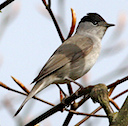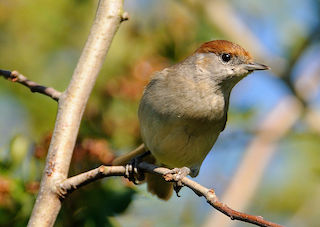
We are more used to seeing Blackcaps in the summer months, but increasing numbers now overwinter in the UK.
Photo: Ron Knight (via Wikimedia Commons)
BLACKCAP
Scientific name: Sylvia atricapilla
Other common names: Northern Nightingale, Mock Nightingale, Haychat, Eurasian Blackcap
Conservation status: IUCN Red List, Least Concern; UK Birds of Conservation Concern, Green
What to look for:
• Family: Warblers
• Colouring and appearance: Olive-grey and buff, but with a distinctive black cap in the male, and equally distinctive chestnut cap in the female and immature male. Both sexes have a short black beak.
• Size: 13 cm length, 20 to 23 cm wingspan.
• Where: Although mainly a summer visitor to the UK, some birds overwinter here, primarily in the south.
• Call: A charming and musical song
• Similar species: Garden Warbler

We are used to welcoming Blackcaps as summer visitors to our shores. They arrive in the spring to breed and raise their young (the total number of breeding territories is about 1.7 million), before returning south in the autumn. However, increasing numbers (currently about 3000 individuals) are being seen here in the colder months. These overwintering birds will often be spotted in gardens, taking advantage of birdfeeders, and also in deciduous woodland and parks.
Interestingly, research is showing that the British winter populations are not the same as those that breed in Britain and Ireland, but instead hail from central Europe. They appear to have adapted their migratory behaviour to overwinter closer to their breeding territory rather than travelling south across the Sahara; this is possibly because the latter strategy has costs in terms of energy and therefore in breeding success.

Blackcap nests, built in shrubs and scrub, are cup-shaped. The female lays a clutch of up to six eggs (buff with grey/brown spots): these hatch in roughly 11 days after incubation by both parents, and then the young take a further 11 days or so to fledge. They mainly feed on insects in the summer months, and on fruit in the winter: garden visitors in winter will also eat typical bird table fare, such as fat and peanuts.
Did you know…?
…The Blackcap’s scientific genus name is derived from the Latin word for woodland sprite, and its species name simply means black-capped; the scientific name therefore refers to both its appearance and preferred habitat.
More information and references:
Svensson, L., Mullarney, K., Zetterstrom, D.,1986. Collins Bird Guide, second edition (translated by Christie, D., Svensson, L.). HarperCollins, London.
Published: December 2020
Author: Amanda Scott
Photos: Male – Ron Knight from Seaford, East Sussex, United Kingdom, CC BY 2.0, via Wikimedia Commons; Female – Kev Chapman, CC BY 2.0, via Wikimedia Commons
